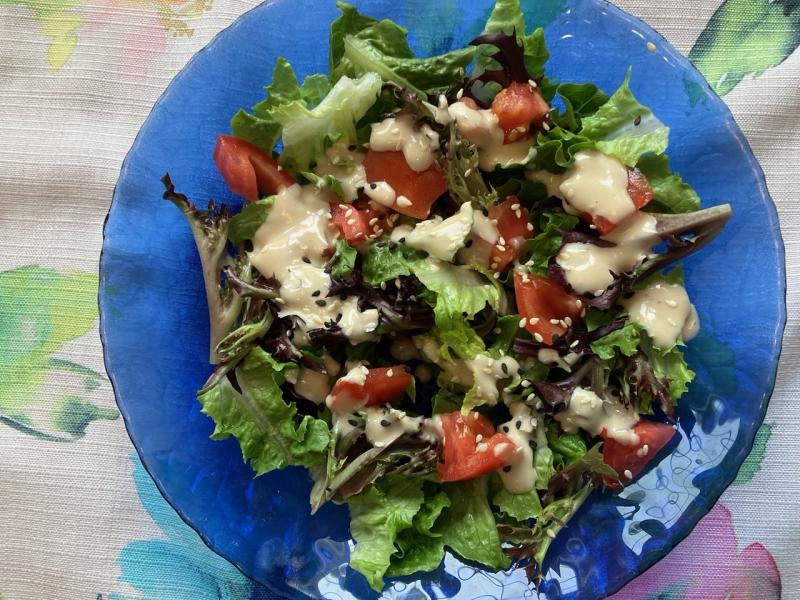Tahini brings Middle Eastern flavor to diverse dishes
Tahini is one of the backbone ingredients in Middle Eastern cuisine, according to authors Sam Tamimi and Tara Wigley. In their cookbook “Falastin,” about the favorite foods of Palestine, you will find this ground sesame seed paste in dishes both sweet and savory.
Tahini or tahina (from the Arabic “tahn” which means ground) is also known as sesame butter and is similar in texture to creamy peanut butter.
The flavor profile of tahini is earthy and nutty, with a subtle sharp hint. You can find it in the international food aisles of most grocery stores and many online retailers. The best tahini will have a smooth, creamy texture and balanced flavor. Thinner, almost pourable tahini is usually better than the sometimes clumpy, gritty texture found in thicker brands.
When producing high-quality tahini, everything matters, from the selection of sesame seeds to the gentle precision of the grinding process. Let me introduce you to Kamel Hashlamon, who personally inspects the sesame seeds destined to be ground on the custom-made black granite millstones he commissioned from a Syrian stonemason. The work is slow and steady to ensure the temperature doesn’t climb too high, and the consistency remains perfectly smooth.
Unlike many tahini brands you will find in this country, this tahini can be poured or spooned directly from the container. The tahini Hashlamon produces doesn’t “split” in the jar; the oil doesn’t separate and sit on top of the paste, but remains completely emulsified. His shop in Abu Ghosh, West Jerusalem, produces four types of tahini that can also be ordered online from his distributor, the East Jerusalem Food company.
White tahini uses shelled and briefly toasted sesame seeds to create a delicate flavor. Seeds that go into red or roasted tahini are toasted for several hours to produce a stronger flavor and an orange-brown color. Whole tahini is made from unshelled seeds, but the expert grinding creates a wonderfully smooth texture. The last type is called black tahini, with its signature mocha color from the addition of nigella seeds.
Nigella seeds, indigenous to the Middle East and a member of the buttercup family of plants, are often called black cumin. With their impressive health benefits, ranging from high antioxidant content to antibacterial and anti-inflammatory properties, the addition of toasted nigella seeds creates a rich-flavored tahini with slightly smoky hints.
There are countless ways to use tahini, the most familiar of which may be in dips such as hummus and baba ghanoush. You’ll find tahini sauces served with salads, grilled meats, roasted vegetables and fried falafel patties. Tahini can add a rich creaminess to soups along with a subtle nutty flavor. Tahini combined with soy sauce, as in the recipe below, makes a great noodle dish. Finally, tahini is a surprise ingredient in flourless chocolate cake.
Tahini Sauce
1/2 C tahini
1/4 C olive oil
2 t apple cider vinegar
1 T honey
1 T lemon juice
1 t grated garlic clove
1/4 t salt
pepper, to taste
sesame seeds, for garnish
Combine ingredients in a blender and process until smooth. Drizzle over salad greens or serve as a sauce with meats and vegetables. Store leftovers in a sealed container in the refrigerator for up to 1 week.
Tahini Broccoli & Noodles
3 T soy sauce
1/3 C tahini
2 T honey
2 t rice wine vinegar
2 grated garlic cloves
1 T hot chili paste
2 T water
1 T toasted sesame oil
4 C broccoli florets
salt & pepper, to taste
10 rice noodles
sesame seeds, for garnish
Make the sauce by combining soy sauce, tahini, honey, vinegar, garlic, chili paste and water. Stir briskly to a smooth consistency; set aside. Heat sesame oil in a skillet over medium. Add broccoli and cook until crisp-tender, about 7 minutes. While broccoli is cooking, prepare noodles according to the package instructions. Drain noodles and place in a serving bowl. Pour sauce over noodles and toss to coat completely. Add broccoli and garnish with sesame seeds.
Tahini Chocolate Cake
7 oz dark chocolate
1/2 C butter
1/2 C tahini
1 C sugar
1/2 C cocoa powder
4 eggs, lightly beaten
1 t vanilla
1/4 t salt
whipped cream (optional)
Preheat oven to 300 F. Grease a 9-inch springform pan with butter and line the bottom with parchment paper; set aside. Bring a small pot of water, one-third filled, to a boil. Place a heat-proof bowl on top of the water, making sure the bottom of the bowl doesn’t touch the water. Add chocolate and butter to melt, stirring until smooth. Whisk in sugar and tahini. Remove bowl from heat; whisk in eggs, vanilla and salt. Stir in cocoa powder until combined. Pour batter into prepared pan and bake for 45 to 50 minutes. Allow to cool for 10 minutes before removing cake from the pan. Cool completely on a wire rack before slicing. Serve with dollops of whipped cream, if desired.























































